Translate this page into:
A case of viral hepatitis C treated with homoeopathy
*Corresponding author: Dr. Hitesh G. Purohit, Department of Homoeopathic Materia Medica, Vadodara, Gujarat, India. drhiteshp@gmail.com
-
Received: ,
Accepted: ,
How to cite this article: Purohit HG, Dodiya K, Tadvi R. A case of viral hepatitis C treated with homoeopathy. J Intgr Stand Homoeopathy. 2023;6:144-51. doi: 10.25259/JISH_46_2022
Abstract
The individual’s susceptibility helps keep the disease at bay; when the vital force alters normal body function also gets disturbed, which results in altered susceptibility and lowered immunity. It affects not only physiological function but also affects the mind. This case report demonstrates the evolution of the patient’s core and illness. It demonstrates the importance of understanding the pathogenesis of the disease and the role of symptom classification, selection of characteristic symptoms, repertorisation, and materia medica differentiation in the process of arriving at the right remedy.
Keywords
LM potency
Chronic hepatitis
Susceptibility
Natrum phosphorus
INTRODUCTION
Hepatitis C is an infectious disease that primarily affects the liver and is spurred by the hepatitis C virus (HCV), a single-stranded RNA virus. It is one of the five hepatitis viruses – A, B, C, D, and E – that is now recognised. It has seven genotypes, and there are several subtypes for each genotype. Patients have experienced minimal to no symptoms during an acute illness. It can occasionally present symptoms including fever, weakness, stomach pain, and jaundice. In roughly 75–85% of instances, the viruses remain dormant in the liver as a chronic infection and cause no symptoms.[1] However, liver disease and occasionally cirrhosis take several years to develop. Liver failure, malignancy, and gastrointestinal tract bleeding brought on by oesophageal and stomach varices are some of its late consequences.[2]
Three case studies by Memon et al. discussed how conventional treatment fails to treat hepatitis C and was successfully cured with Chelidonium, Natrum sulphuricum, and Carduus marianus.[3] Another case series documented by Gupta and Pandey also explained the role of homoeopathic medicines in treating chronic hepatitis C. Out of thirteen cases, the viral load was significantly reduced in 6 patients (46.15%), was reduced to below the detection threshold in three cases (23.08%), and did not respond to therapy in four cases (30.77%).[4]
CASE REPORT
The patient was admitted to homoeopathic in-patient department (IPD).
Mr: C., Age: 42 years, Education: B A, Married
Employment: Unemployed, in the past 9 months
Date of case taking: December 03 2020.
Chief complaints
The chief complaints [Table 1] are written in the location-sensation-modality-concomitant format for better understanding.[5]
| Location | Sensation and pathology | Modalities | Accompaniments |
|---|---|---|---|
| GIT since 2018 1st Episode Rt Hypochondriac To the Right, Lower Back Continuous |
Nausea++Vomiting++Ingesta Food, Water quantity:+ to++ No smell Fever on and off temp 100–101 F Pricking pain++ Diagnosed: Hepatitis C |
<+++ Smell of oily, Fried food <++ Riding in the bike: Jerks <++ Lifting heavyweight |
Weakness++ Ghabrahat++Headache++ >++ pressure |
| 2nd Episode: Oct 2019 |
Same symptoms Same symptoms+ Vomiting of blood, |
>+++ Treatment HEPCVEL ETC >+++ Binding and insert Ring in the oesophagus. |
Weakness++ |
| 3rd Episode: June 2020 once/twice in a day/week Nov 2020. (Discontinue treatment in July 2020) |
Quantity: ++ Colour: dark blood Feverish feelings++ Appetite: Reduced++ Endoscopy: Ulcerations in Oesophagus except Haematemesis all the symptoms started same I/F Weight loss 10 kg in 2 years |
>Allopathic treatment since one month | |
| Locomotor since one month daily Both hands Metatarsal Joints and knee joint |
Pain++ Stiffness++ No swelling |
< ++ Morning >++ Movement >Exercise |
GIT: Gastrointestinal tract
Physical characteristics
Medium Built, Whitish complexion.
Perspiration: Profuse Face++, Head++. Cravings: Chicken++ Farinaceous Foods++, Pungent++, Pulse++
Sleep: Disturbed due to Anxiety about health,
Dreams: Dead relatives++, Nightmares++, Fighting++, Being murdered++
Thermal state: Chilly.
Past History: 2015 : ? Meningitis? Hydrocephalus 5 years ago. No reports are available.
Understanding patient as a person
Childhood
The patient grew up in a joint family in Uttar Pradesh. It was a large joint family. Father was dominating++, irritable++, and refused to listen to anyone. Father used to fulfil his wish in his own way. Father was working in Railways and was an alcoholic. Mother was a housewife and was described as cool and calm. The patient had a good relationship with his mother. The patient did not like the nature of his father and had regular arguments with him. He had good interpersonal relations with everyone except his father. He used to cry during disagreements and would not speak with his father for 2–3 days. The elder brother was mature and helpful. The patient was attached to all three brothers. He used to easily mix with others. He had a good friend circle in childhood.
Education
The patient completed B.A. and was average in the studies. Since entering college, he enjoyed playing various sports and was mainly involved in football and hockey. Now, he regrets being unable to participate in sports due to his current sickness. He had a habit of smoking and drinking since graduation.
Loss of youngest brother (2002)
Youngest brother expired at the age of 16 in an accident. He passed away in front of the patient. It produced a tremendous impact on the patient as he was much attached to his brother. It was a period of Grief++. He remained sad ++, his sleep was disturbed, and he remembered his brother all the time. He was sensitive and wept bitterly while narrating about this incident.
He changed five jobs within five years. He attributed reasons for changing jobs to better monetary prospects and differences with colleagues.
The patient completed a one year course in Accountancy in the year 2011. He started his career as an accountant in a multinational bank.
He joined a telecommunications company as an accountant with a better package in the year 2012. Father’s health was worsening. He decided to leave the job to take care of his father. It was difficult for his elder brother to take leave/quit the job as he was promoted as a manager. Younger brother was in a government job as a teacher.
He joined Job in 2015 after a total recovery of his father’s health. He ran into trouble due to ego conflicts with his supervisor, who was younger than him. Thus, he was fired very soon and became jobless for a short while. It caused a change in his behaviour, such as being agitated over little matters, preferring to be alone, and not wanting to converse even with his closest friends. Sleep was seriously disturbed. He described not being able to sleep for 10 days. He consulted a Psychiatrist who treated him for suffering from depressive disorder. He took treatment for 3–4 months and improved.
In 2016–17, his elder brother gave him financial support so he could start a credit society with a friend. He began to collect money from the people and lend it to those in need at a greater interest rate. He was cheated on by his friend, whom he trusted. He suffered a loss of 80,000 rupees. He said that he handled his business carelessly and regretted it. The patient used to brood ++ constantly that ‘I should have done better, I had the capacity to do it.’ He thought of committing suicide. He went for it but again started thinking that, after committing suicide, his family would suffer more and suicide was not a solution, so he returned. He thought, ‘Those who keep trying will eventually succeed.’
Once again, with his elder brother’s help, he started a business providing chemicals for detergent products. The patient gave Rs 1 lakh on interest to one of the suppliers from the business account. The supplier never returned the money; hence, the business went into financial difficulties due to the non-availability of the money. He has to close down.
His elder brother learned about financial transactions. They had a bitter argument. For six months, brother did not speak with him. During festivals, when they met, they just exchanged pleasantries. He was sad ++ and disappointed +++ in himself for making a decision that had ruined his life. The fact that the brother remained silent added to the sadness. He felt lonely ++.
He started a job in a small town in a courier company. He had difficulty related to more workload. He did not like the behaviour of the Manager towards the employees. He left the Job.
He then joined a food delivery company in a hill town in North India. He was staying away from family. His father’s health deteriorated. He decided to leave the Job and return to his native place to take care of his health. At his native place, he started the Job in a courier company. Due to COVID-19, the courier company was closed. He was unemployed and faced many financial crises. Household expenses were managed by his father’s pension. He does not feel good about this.
Marriage life
He described that bad life situations did not affect marriage life. His wife is a good-natured person. He shares all the problems with his wife. He is more anxious and worried about his and his children’s future. The patient said, ‘My wife supports me in all my difficulties.’
Relations with younger brother
Younger brother is a primary government teacher. He has a good income. His younger brother likes to show off his success in life. He has an average relationship with his younger brother. The younger brother is of a dominating nature; hence, the patient does not like it.
Personal behaviour
The patient described himself as rigid/egoistic and irritable +++. Earlier, he was happy and of a jolly nature. His nature has changed since 2015. He became more aggressive, and now loses his temper soon. If anyone talks to him in a louder tone, he will reply with a raised voice. He cannot tolerate injustice to anyone. He loses his temper with a feeling that he will do anything in fit of anger, but can’t do anything. He had a desire to take revenge with an individual who did injustice to self or others.
He is helpful ++ by nature and cannot see the pain of the poor. He helps in whatever possible way to the needy person. He is extremely emotional and tears roll down while watching movies. He feels better and relaxed after crying. He described his memory as good and perfect at work. He is guilty ++ of the wrong decision in life, and currently, his family is dependent on his father’s pension. He is attached to his parents and elder brother’s family.
He has a fear of heights, fast speed, and seawater. He has frequent dreams of being murdered – someone is killing him by knife, and dead relatives, especially his brother. The entire family strongly believes in god, while the patient is an atheist. During the interview, he answered in a hurried manner.
Investigations:
[Table 2].
| Date | 3/12/2020 | 7/12/2020 | 15/12/2020 | 3/12/2020 | 7/12/2020 | 15/12/2020 | |
|---|---|---|---|---|---|---|---|
| Investigation | REPORT | REPORT | REPORT | REPORT | REPORT | REPORT | |
| CBC: HB RBC count Indices CI VI PCV MCV MCH MCHC |
13.4 4.49 38.6 85.97 29.84 34.72 |
13.10 | WBC: Total Neutrophils Leucocytes Eosinophils Monocytes Basophil Platelets | 6500 72 22 3 3 0 1,12,000 |
9130 55 33 8 3 1 79000 |
||
| Renal function test BUN Serum creatinine Uric acid E.GFR |
18.5 1.19 8.6 |
8.2 |
1.1 7.9 73 |
Liver function test Protein: Total Albumin Globulin A: G ratio |
9 4.7 4.3 1.09 |
8.5 4.7 3.8 1.23 |
9.1 4.8 4.3 1.1 |
| Serum SGOT SGPT AlK.PO4 Bilirubin: T D INDIRECT GGT |
143 100 144 1.6 0.7 0.9 |
76 81 117 1.2 0.4 0.8 |
61 66 611 0.6 0.3 0.3 447 |
LIPID PROFILE Total LDL HDL VLDL RATIO |
213 125 61 26 2.05 |
||
|
October 20, 2020: SONOGRAPHY abdomen and pelvis: Mild hepatomegaly with coarse hepatic echo texture and grade one fatty damage, mild splenomegaly and. grade one fatty change in pancreas. October 21 2020: Hepatitis C Viral (HCV RNA) QUALITATIVE REAL TIME PCR: - Result: 15892739 IU/ML Ref range: > 1.77 * 10: HCV RNA detected above the linear range of the assay [Figure 1] |
|||||||
MCV: Mean corpuscular volume, MCH: Mean corpuscular haemoglobin, MCHC: Mean corpuscular haemoglobin concentration, SGPT: Serum glutamic pyruvic transaminase, SGOT: Serum glutamic oxaloacetic transaminase, AlK.PO4: Alkaline phosphatase, GGT: Gamma-glutamyl transferase,
LDL: Low-density lipoprotein, HDL: High-density lipoprotein, VLDL: Very low-density lipoprotein
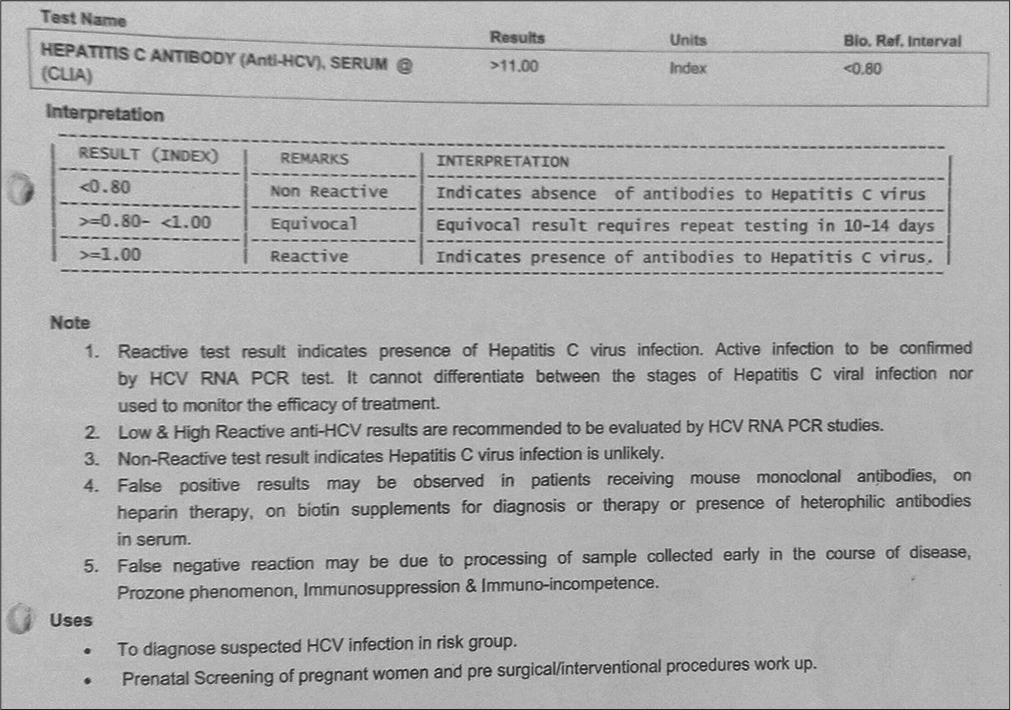
- Hepatitis C viral (HCV RNA) qualitative real time PCR.
Totality of the case
Repertorisation done using Repertorial Syndrome (RS) and Potential Differential Field (PDF) methods
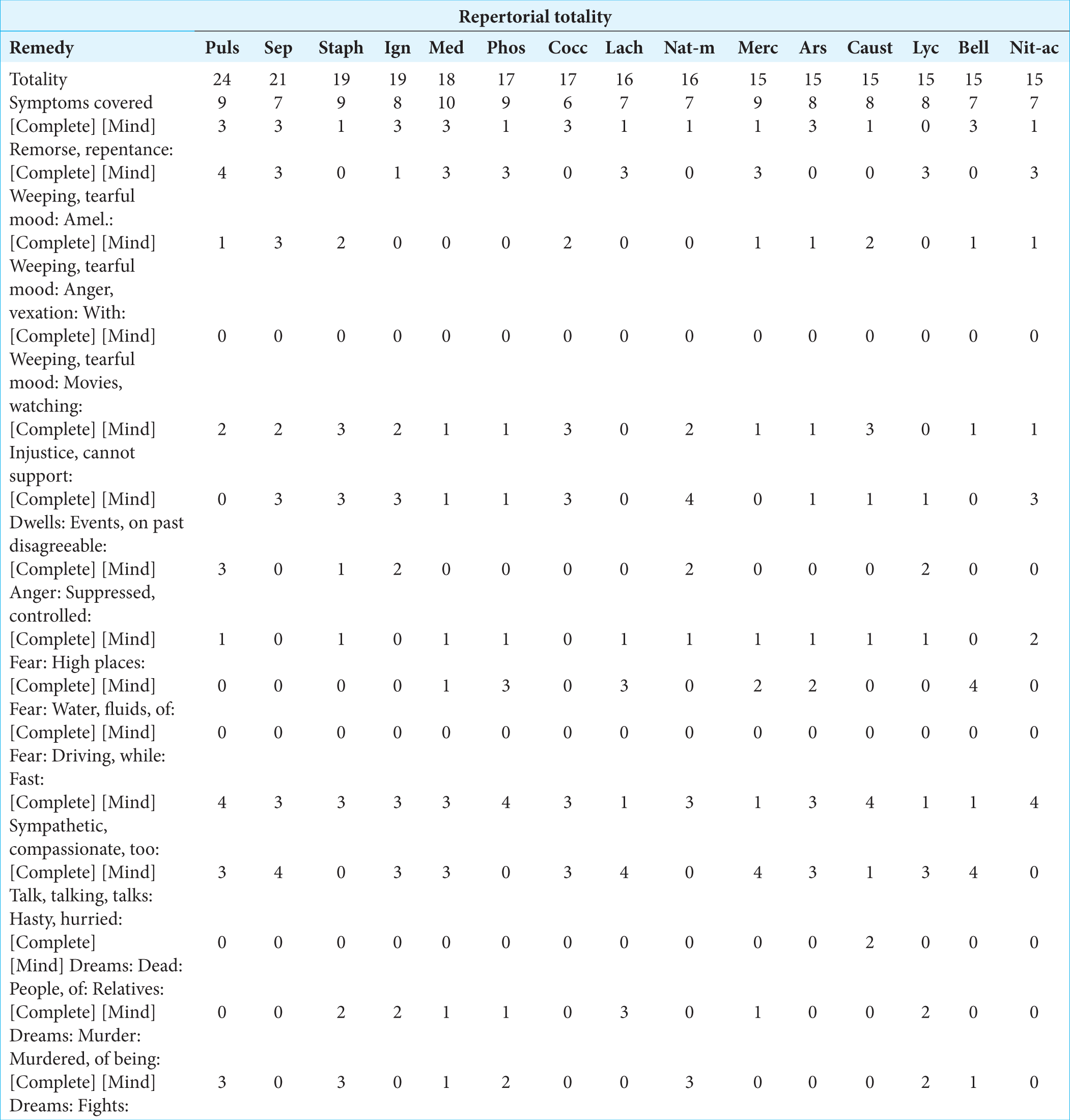
- Repertorisation sheet - zomeo pro (acute + tempraz).
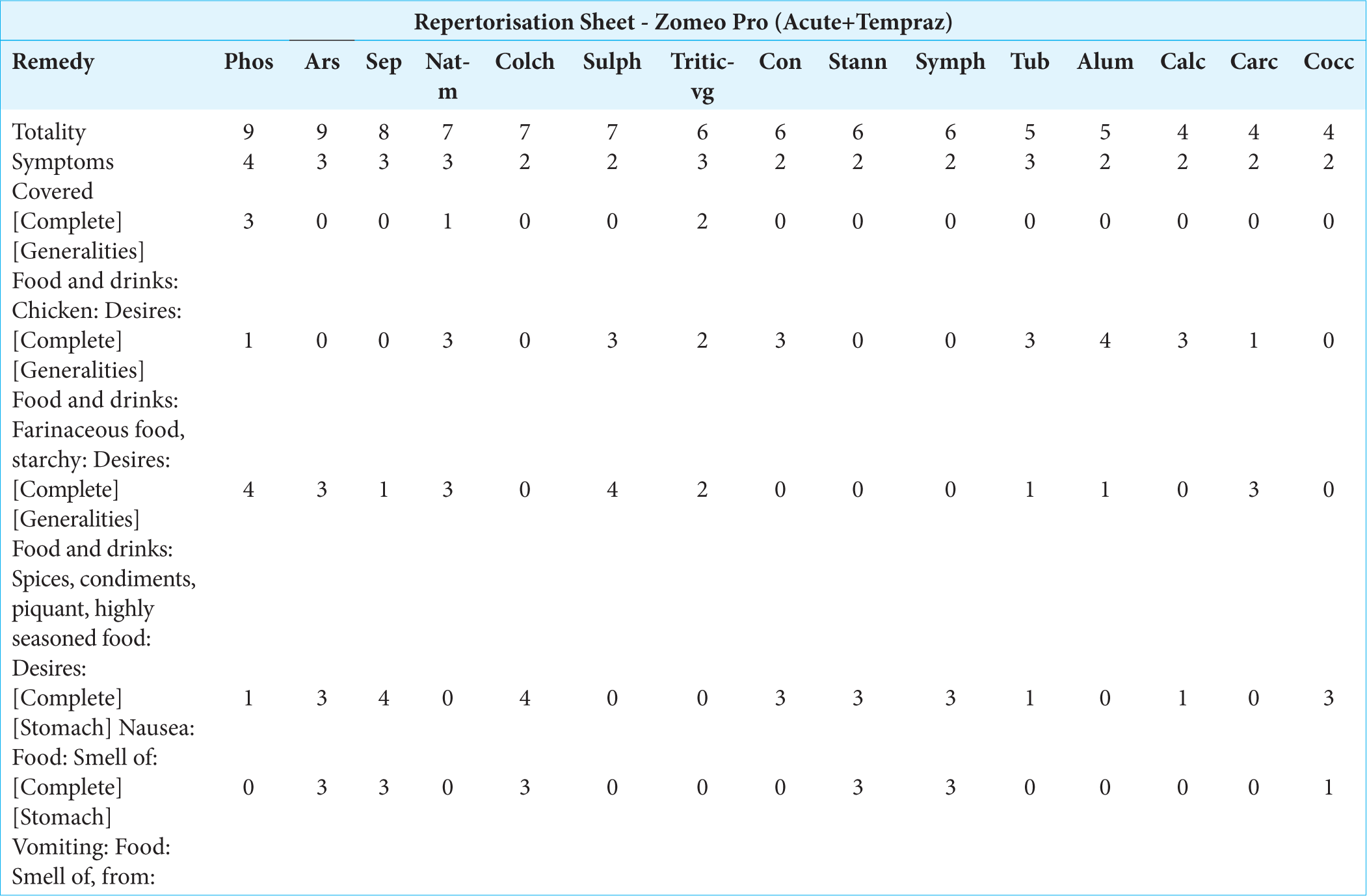
- Potential differentiation field.
Understanding of the case:
The way an individual has evolved since childhood speaks of sensitivity to injustice, irritability, tendency to suppress anger, and brooding over the past. He is an emotional person, and all his decision-making is governed by emotions, which has led to faulty decision-making and has caused him unhappiness and disappointment. He has an ambivalent relationship with his father. On the other hand he is sympathetic and fearful of various inputs. All the above symptoms are suggestive of a Natrum core. Natrum Muraticum, Natrum Sulphuricum, and Natrum Phosphorus come close for differentiation.
Natrum Sulphuricum comes close with a phase of withdrawal, depression, and involvement of the liver as a target organ. Sensitive to injustice with authority, irritability, brooding, the tendency to suppress anger, and ambivalent relations with the involvement of the brain and liver bring Natrum Muraticum into the picture. When we try to incorporate – the qualified fears, sympathetic nature and weeping ameliorates, peculiar cravings and nausea < smell and pathogenesis of inflammation progressing to degenerative liver changes brings Natrum Phosphorus as a remedy.
Final selection of remedy-Natrum Phosphorus
Planning and programming: [Table 3]
Final prescription - NAT. PHOS 0/1 TDS
Patient admitted in IPD December 03, 2020–December 07, 2020
-
Follow-up criteria:
Weakness
Appetite
Nausea and vomiting
Mouth bleeding
Pain in the interphalangeal joint (I/F/D)
Pain in metacarpophalangeal (MCP) joint (I/F/D)
Pain in the knee joint (I/F/D)
Stiffness in the interphalangeal joint (I/F/D)
Stiffness in MCP joint (I/F/D)
Stiffness in the knee joint (I/F/D) 11. On examination – P/A, blood pressure
Follow-Up summary
| Define the reasons the states | Potency choice | Repetition |
|---|---|---|
| 1. Susceptibility: Moderate Age/sex: 42/M Pace: Rapid Structural reversible Characteristic :++ |
0/1 | Frequent |
| 2. Sensitivity: Good Mind+3 Nerve+2 |
0/1 | Frequent |
| 3. Vitality: Good | Infrequent | |
| 4. Correspondence: Total Mind+3 Body+2 |
Nat Phos | Frequent |
| 5. Structural changes: +++ Reversible-Degenerative Changes in hepatocytes | 0/1 | Frequent |
| 6. Fundamental miasm: Fa: MI-Tubercular | 0/1 | Infrequent |
| 7. Dominant miasm: Tubercular | 0/1 | Infrequent |
Later on medicines for 3 month were sent, as patient could not personally come to the hospital, due to the COVID-19 pandemic. Subsequently, he was kept on a placebo and his brother would regularly follow up over the telephone [Table 4].
| Date | Symptoms changes | Interpretation (I) Expectation (E) |
Prescription |
|---|---|---|---|
| 17/12/2020 | Energy-good Sleep-good App-good No GIT complaint Looking fresh No pain and stiffness in joints |
BP-140/100 Wt-59kg Stops anti-hypertension on its own |
NAT PHOS 0/1 QDS |
| 31/12/2020 | Energy-good Sleep-good App-good No GIT complaint No pain and stiffness in joints |
BP-140/80 Wt-60 kg Advised anti-viral load, USG abdomen |
NAT PHOS 0/1 QDS |
| 4/2/2021 | Energy-good Sleep-good App-good No GIT complaint. No pain and stiffness in joints. The patient is feeling discomfort while eating and has a headache. |
BP-130/90 Wt-60 kg Borderline hepatomegaly with mild splenomegaly |
NAT PHOS 0/3 BD |
| 11/2/2021 | Energy-good Sleep-good App-good No GIT complaint No pain and stiffness in joints. No headache and no discomfort felt during eating. |
BP-130/78 Wt-60 kg Viral load negative [Figure 4 ] |
NAT PHOS 0/3 BD |
| 8/4/2021 | Energy-good Sleep-good App-good No GIT complaint No pain and stiffness in joints. |
BP-134/96 Wt-62 kg Viral load negative [Figure 5] |
NAT PHOS 0/3 TDS |
USG: Ultrasonography, GIT: Gastrointestinal tract, BP: Blood pressure, Wt: Weight, NAT PHOS: Natrum phosphorus
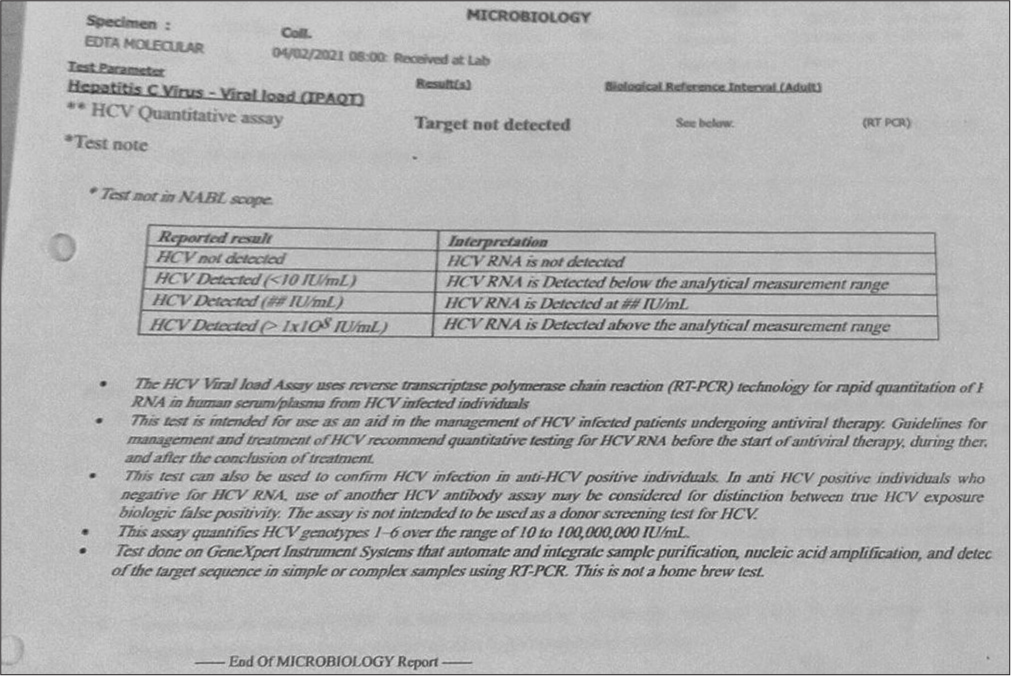
- Hepatitis C viral (HCV RNA) qualitative real time PCR.
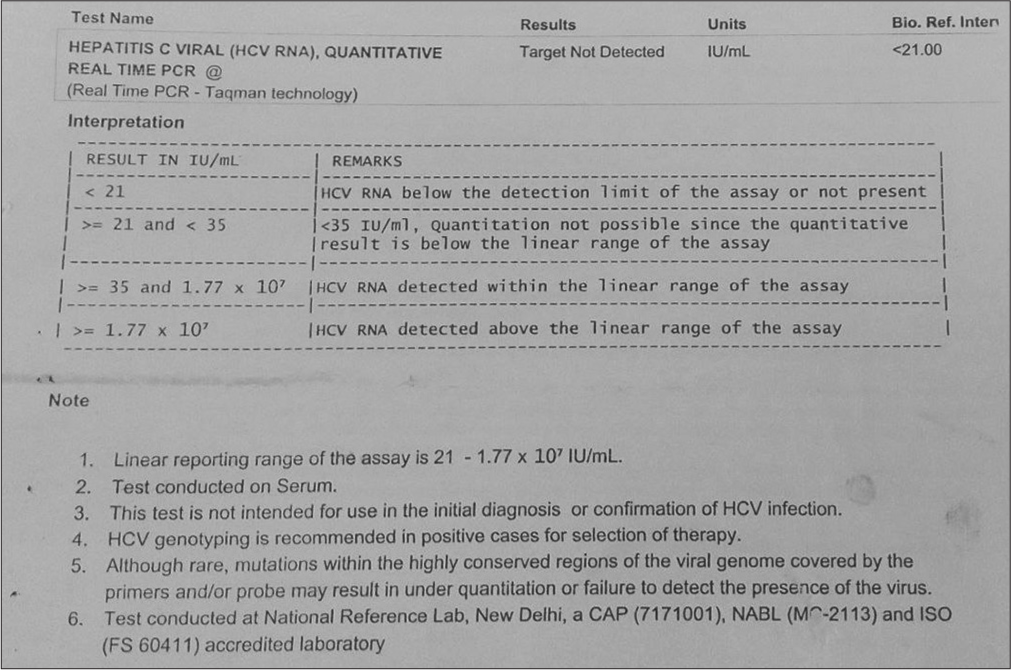
- Hepatitis C viral (HCV RNA) qualitative real time PCR.
DISCUSSION
We were able to see how emotions such as sadness and guilt act as the precipitating factors for the development of the disease and impact the susceptibility of an individual. Natrum Phosphorus was selected based on a holistic understanding of the patient, which brought about improvement in the subjective symptoms, objective symptoms and investigations reports had marked improvement. We were able to bring the viral load to be negative. The patient was stabilised at all levels. Potency selection was crucial. The LM potency was the right selection. It has helped susceptibility to improve. The patient improved and remained normal at both subjective/objective symptomatology and clinical investigations. Serial Ultrasonography demonstrates the arrest of further development of liver parenchyma disease after starting homoeopathic treatment.
CONCLUSION
In this case report, homeopathy helps to treat the fundamental cause of hepatitis C infection and individual vulnerability. Homoeopathy provides a cure by cleaning and eliminating viral cells, boosting the immune system, and encouraging the development of healthy cells for hepatitis C. Regarding therapeutic medication, numerous effective options for treating Hepatitis C can be chosen based on the complaints’ cause, sensation, and modality; however, further studies with a larger sample size would be needed to draw more conclusions.
Ethical approval
The Institutional Review Board approval is not required.
Declaration of patient consent
The authors certify that they have obtained all appropriate patient consent.
Conflicts of interest
There are no conflicts of interest.
Use of artificial intelligence (AI)-assisted technology for manuscript preparation
The authors confirm that there was no use of artificial intelligence (AI)-assisted technology for assisting in the writing or editing of the manuscript and no images were manipulated using AI.
Financial support and sponsorship
Nil.
References
- Treatment of hepatitis C: A systematic review. JAMA. 2014;312:631-40.
- [CrossRef] [PubMed] [Google Scholar]
- Hepatitis C: An epidemiological review. J Viral Hepat. 2002;9:84-100.
- [CrossRef] [PubMed] [Google Scholar]
- Homeopathic treatment and prevention of hepatitis C. J Tradit Med Clin Naturop. 2018;7:255.
- [CrossRef] [Google Scholar]
- Role of homoeopathic medicines in the patients of chronic hepatitis-C. Adv Homoeopath Res. 2017;2:24-32.
- [Google Scholar]






